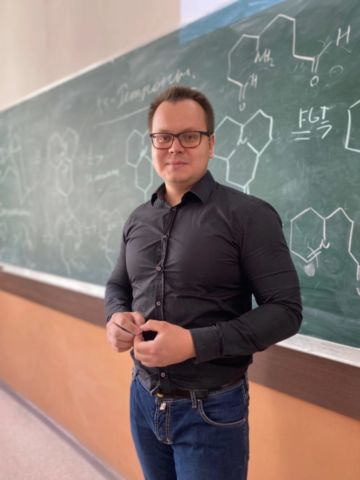The prestigious international journal “Journal of Materials C” published an article on the “Creation of D-A-D-dyes with far-infrared radiation...”, one of the authors of which was Timofey Chmovzh, senior researcher at the Nanotechnology Research Centre of South Ural State University, together with his colleagues from the P.N. Lebedev Physical Institute of the Russian Academy of Sciences, the N.D. Zelinsky Institute of Organic Chemistry and M.V. Lomonosov Moscow State University. The dyes they developed, with phosphoresce in the range of 900-1110 nanometers, can be used in oncology for marking tumour cells.
Everyone knows luminophors (or phosphors) – substances that can luminesce, that is, emit light by absorbing energy. Some substances glow in the infrared range. Modern technologies often use this effect: in night-vision devices, in sensors, in all kinds of devices related to image processing.
Of particular interest, but also particularly challenging, are phosphors for oncology medicine. By “tinting” or “highlighting” unhealthy cells, you can target them using laser, radiation, and chemical therapy. However, the burden on the body of a cancer patient is already high, so the phosphor dye must have minimal cytotoxicity. In other words, it must be safe for cells, most of which are healthy, and doctors will deal with unhealthy cells themselves.
Luminescence is not a thermal glow. What is its physical nature? Under the influence of external radiation, an atom or molecule is activated, and the electrons in it move from one level to another.
What is needed to highlight cells, to make the radiation stable, while doctors perform manipulations, and to make it penetrate the cell membranes?
Senior researcher at the Nanotechnology Research Centre Timofey Chmovzh and his colleagues consider D-A-D dyes. They have donor fragments rich in electrons, and there is an acceptor part – electron recipients. To ensure optimal transfer of electrons from the donor to the acceptor part of the molecule, scientists are trying to develop new strategies for their salting, including introducing additional aromatic rings between them: phenyl and thiophene (this ensures π-conjugation).
The goal is to circumvent Kashi's rule, named after the American physicist. According to this rule, no matter what wavelength excited the molecule, it will always emit light in the same spectrum. The gap between the wavelengths of the absorbed and emitted waves is determined by the Stokes shift.
Creating dyes that do not obey Kashi's rule is a difficult task. Not many dyes emit near-infrared light above 900 nanometers, and even fewer emit above 1000 nanometers.
Timofey Chmovzh and his colleagues synthesized new dyes that stably phosphoresce in the region of 900-1100 nanometers. The scientists for the first time used 1,2,5-selenodiazolo[3,4-d]pyridazine as the acceptor part of the molecule. The role of donor blocks was played by carbazole molecules and dehydroindol derivatives.
Cytotoxicity tests of the drug were conducted on the cells of the paramecium caudatum. The experiment showed that the cell, under the influence of the new substance, which contained namely carbazole donor fragments, did not experience any harmful effects, at least in the concentration of the dye, which doctors could use to dye cells. It is hoped that it will also be safe for humans.
The SUSU Nanotechnology Research and Education Centre solves a wide range of problems in materials science both in the study of nanomaterials and in the study of widely used materials (metals and alloys, ceramics and glass, construction, polymer, composite, and others). The work is carried out within the frameworks of megagrants of the Russian Science Foundation under the Science and Universities national project and the regional project on the "Development of Large-scale Research and Scientific and Technological Projects in Priority Research Areas".




